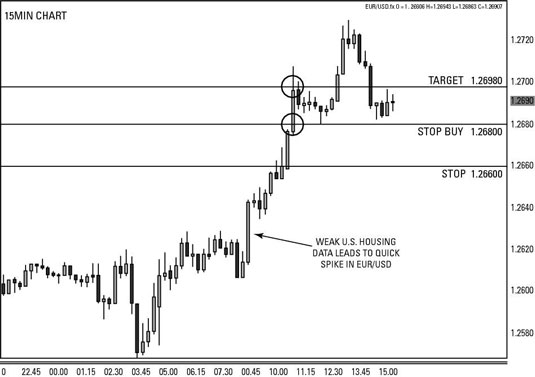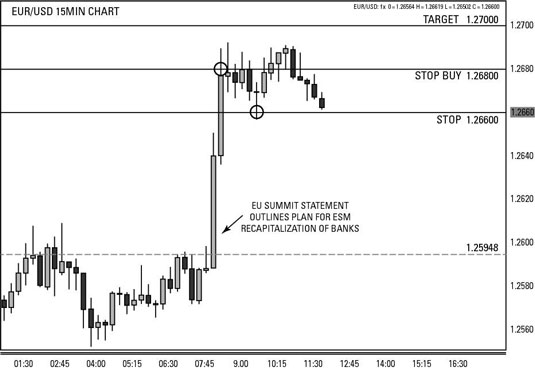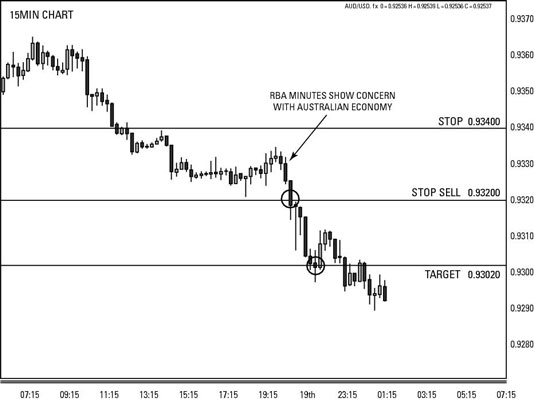The Red Zone Currency Trading Strategy for the Scalper
News trading (buying and selling around high-impact economic data) is notoriously difficult, to the point that many traders intentionally close all their trades ahead of major news reports such as non-farm payrolls (NFP) or central bank meetings. In order to be successful with this style of trading you need to have a predetermined and disciplined structure – you don’t want to randomly place emotional trades.
One potentially effective strategy is to take advantage of the markets’ tendency to gravitate towards round numbers, such as 1.3200 in a currency pair like EUR/USD. These levels are important for two main reasons:
1- New traders often place stop-loss orders at or around these levels.
2- Option strike prices are largely set at the round handles.
With such a large segment of traders focusing on these areas, it is no wonder that they exert a strong influence on the market. The difficulty is deciding how to design a trading strategy to take advantage of this trend.
To describe the strategy of the red zone, we like to evoke the analogy of a football match. The last 20 yards before the end zone, where historically good teams have scored 50 percent to 70 percent of the time, is referred to as the “red zone.”
For non-US readers, this area is like the penalty area in your version of soccer [which Americans call soccer], where the team is more likely to score with any open shot.
Note that in both examples (soccer and soccer, soccer, soccer), the outcome is not guaranteed – it’s more likely.
The same idea can be applied to trading. When the instrument comes within 20 points of a round number (the “red zone”), that round number becomes more likely to persist, especially after a supportive news event.
How it works
Here are the red zone strategy buying rules:
1- Wait for a movement driven by the news.
2- Set a buy stop order at 0.xx80 ($xx8.00 for gold, $xx.80 for oil).
3- Set a target at 0.xx98 ($9.80 for gold and $98 for oil).
4. Set your stop loss at 0.xx60 ($xx6.00 for gold, xx60 for oil).
Here are the rules for selling the red zone strategy:
1- Wait for a movement driven by the news.
2- Set a sell stop order at 0.xx20 ($xx2.00 for gold and $xx.20 for oil).
3- Set a target at 0.xx02 ($xx0.20 for gold, $xx.02 for oil).
4- Set your stop loss at 0.xx40 ($xx4.00 for gold, $40 for oil).
Since this is a short term trading strategy, you want to trade heavily traded markets such as major currency pairs, gold, oil and widely followed indices, with low spreads. You may also want to focus on trading only during times of high liquidity (when many different traders are buying and selling) to improve speed of entry and exit.
The red zone strategy is underway
Example 1: Buying EUR/USD
This first example demonstrates the perfect execution of the strategy. After the release of the weak US housing data, the EUR/USD rose strongly towards 1.2700. In anticipation of a continuation of that level, the strategy suggested placing a buy stop at 1.2680 with a stop loss at 1.2660 and a target at 1.2698.
When the buy order was triggered, the EUR/USD kept hitting the target within 15 minutes for a profitable trade. Although the EUR/USD eventually rose another 20 pips, the most likely trade was the initial rally to 1.2700.

Example 2: EUR/USD Buy
A few weeks later, the EUR/USD was making another run for the 1.2700 handle after the announcement of a new European Stability Mechanism (ESM) for supporting the European banking sector. As in the preceding example, a buy-stop order was set at 1.2680 with a stop loss at 1.2660 and a target at 1.2698.
In this case, though, rates lost momentum before reaching 1.2700 and hit the stop about an hour after entry for a 20-pip loss. The failure to continue up to 1.2700 foreshadowed further consolidation, and prices eventually rolled over. When the currency pair reverses 20 pips from the entry, the probability of a move up to the round number decreases.

Example 3: AUD/USD Sell
The final example is a sell scalp on the AUD/USD. After dovish Reserve Bank of Australia (RBA) minutes, rates were approaching the 0.9300 level from the topside, and the strategy suggested setting a sell-stop order at 0.9320 with a stop loss at 0.9340 and a target at 0.9302.
Following entry, the pair sold off to hit the target for an 18-pip gain within an hour. Although the AUD/USD did continue to drop from there, the Red Zone strategy is only concerned with taking a small, higher-probability slice out of news-driven moves.

